Page 914 of 3383
FRONT DOOR LOCKBL-133
C
DE
F
G H
J
K L
M A
B
BL
Revision: November 2009 2006 QX56
11. Separate the outside handle cable connection from the outside
handle bracket.
INSTALLATION
Installation in the reverse order of removal.
CAUTION:
To install each rod, be sure to rotate the rod holder until a click is felt.
Disassembly and AssemblyEIS0062B
DOOR KEY CYLINDER ASSEMBLY
Remove the key cylinder escutcheon pawl and remove the door key cylinder.
PIIA5059E
PIIA4136E
Page 943 of 3383

BL-162
BODY REPAIR
Revision: November 20092006 QX56
1. Hoodledge assembly (RH, LH)
2. Hoodledge reinforcement (RH, LH)
3. Body mounting bracket (RH, LH)
4. Hoodledge front brace (RH), Battery mounting bracket (LH)
5. Harness connector bracket
6. Rear floor reinforcement
7. Rear floor
8. Rear floor reinforcement
9. Rear floor side (RH, LH)
10. Crossmember
11. Second seat rear crossmember
12. Second seat front crossmember
13. Rear front seat crossmember
14. Second Body crossmember
15. Front floor
16. Front seat front crossmember
17. Front floor reinforcement
18. Outer sill (RH, LH)
19. Second crossmember extension
20. Rear crossmember end
21. Rear lower crossmember end
22. Rear crossmember end (RH, LH)
23. Rear side member rear reinforcement (RH, LH)
24. Rear side member (RH, LH)
25. Rear side member reinforcement (RH, LH)
26. Inner sill extension (RH, LH)
27. Rear crossmember
28. Upper dash top
29. Upper dash bottom
30. Cowl top
31. Lower dash
32. Lower dash insulator (RH)
33. Lower dash reinforcement
34. Side dash (RH, LH)
35. Lower dash insulator
Page 955 of 3383
BL-174
BODY REPAIR
Revision: November 20092006 QX56
DESCRIPTION
�All dimensions indicated in the figures are actual.
�When using a tracking gauge, adjust both pointers to equal length. Then check the pointers and gauge
itself to make sure there is no free play.
�When a measuring tape is used, check to be sure there is no elongation, twisting or bending.
�Measurements should be taken at the center of the mounting holes.
�An asterisk (*) following the value at the measuring point indicates that the measuring point on the other
side is symmetrically the same value.
�The coordinates of the measurement points are the distances measured from the standard line of "X", "Y"
and "Z".
LIIA1506E
Page 1002 of 3383
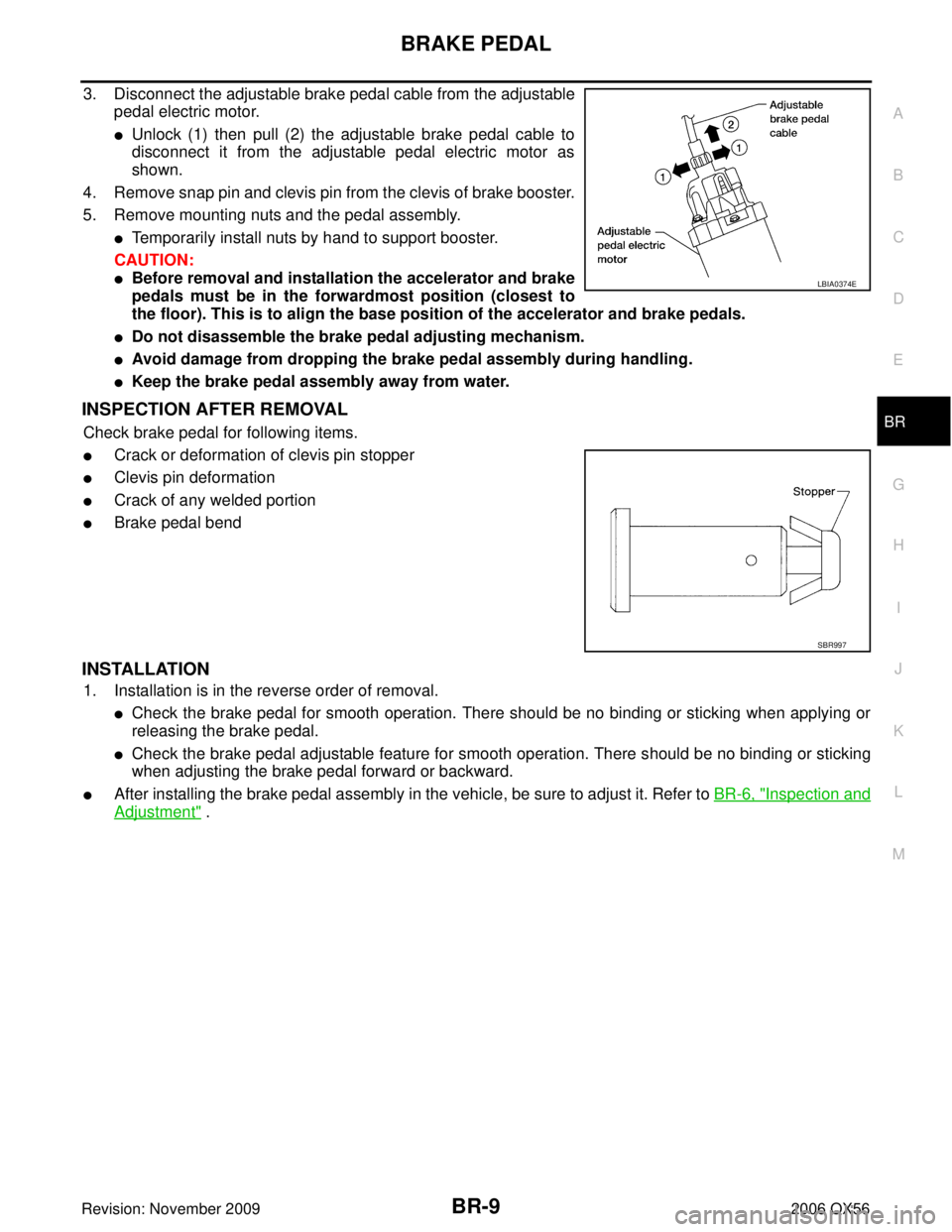
BRAKE PEDALBR-9
C
DE
G H
I
J
K L
M A
B
BR
Revision: November 2009 2006 QX56
3. Disconnect the adjustable brake pedal cable from the adjustable
pedal electric motor.
�Unlock (1) then pull (2) the adjustable brake pedal cable to
disconnect it from the adjustable pedal electric motor as
shown.
4. Remove snap pin and clevis pin from the clevis of brake booster.
5. Remove mounting nuts and the pedal assembly.
�Temporarily install nuts by hand to support booster.
CAUTION:
�Before removal and installation the accelerator and brake
pedals must be in the forwardmost position (closest to
the floor). This is to align the base position of the accelerator and brake pedals.
�Do not disassemble the brake pedal adjusting mechanism.
�Avoid damage from dropping the brake pedal assembly during handling.
�Keep the brake pedal assembly away from water.
INSPECTION AFTER REMOVAL
Check brake pedal for following items.
�Crack or deformation of clevis pin stopper
�Clevis pin deformation
�Crack of any welded portion
�Brake pedal bend
INSTALLATION
1. Installation is in the reverse order of removal.
�Check the brake pedal for smooth operation. There should be no binding or sticking when applying or
releasing the brake pedal.
�Check the brake pedal adjustable feature for smooth operation. There should be no binding or sticking
when adjusting the brake pedal forward or backward.
�After installing the brake pedal assembly in the vehicle, be sure to adjust it. Refer to BR-6, "Inspection and
Adjustment" .
LBIA0374E
SBR997
Page 1005 of 3383
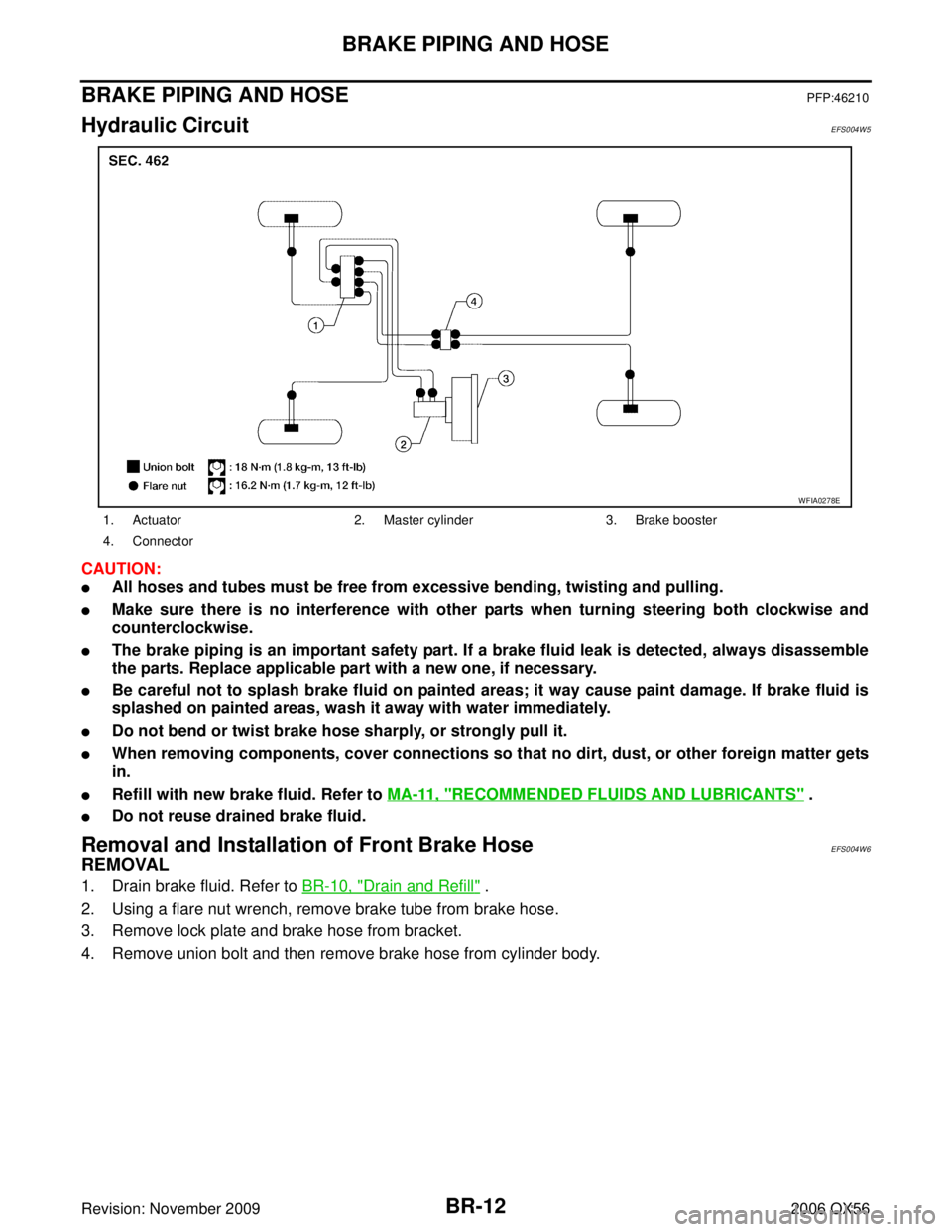
BR-12
BRAKE PIPING AND HOSE
Revision: November 20092006 QX56
BRAKE PIPING AND HOSEPFP:46210
Hydraulic CircuitEFS004W5
CAUTION:
�All hoses and tubes must be free from excessive bending, twisting and pulling.
�Make sure there is no interference with other parts when turning steering both clockwise and
counterclockwise.
�The brake piping is an important safety part. If a brake fluid leak is detected, always disassemble
the parts. Replace applicable part with a new one, if necessary.
�Be careful not to splash brake fluid on painted areas; it way cause paint damage. If brake fluid is
splashed on painted areas, wash it away with water immediately.
�Do not bend or twist brake hose sharply, or strongly pull it.
�When removing components, cover connections so that no dirt, dust, or other foreign matter gets
in.
�Refill with new brake fluid. Refer to MA-11, "RECOMMENDED FLUIDS AND LUBRICANTS" .
�Do not reuse drained brake fluid.
Removal and Installation of Front Brake Hose EFS004W6
REMOVAL
1. Drain brake fluid. Refer to BR-10, "Drain and Refill" .
2. Using a flare nut wrench, remove brake tube from brake hose.
3. Remove lock plate and brake hose from bracket.
4. Remove union bolt and then remove brake hose from cylinder body.
1. Actuator 2. Master cylinder 3. Brake booster
4. Connector
WFIA0278E
Page 1006 of 3383
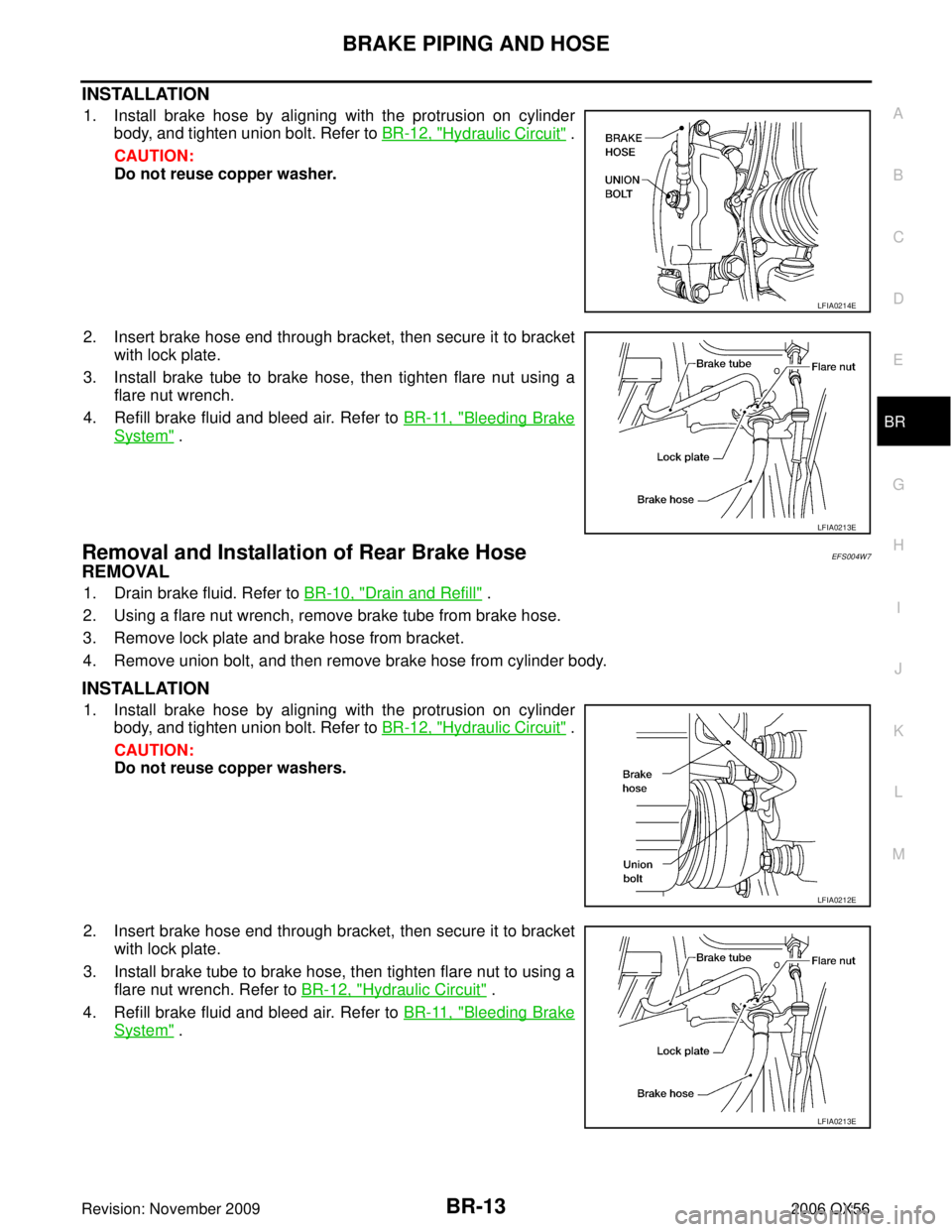
BRAKE PIPING AND HOSEBR-13
C
DE
G H
I
J
K L
M A
B
BR
Revision: November 2009 2006 QX56
INSTALLATION
1. Install brake hose by aligning with the protrusion on cylinder
body, and tighten union bolt. Refer to BR-12, "
Hydraulic Circuit" .
CAUTION:
Do not reuse copper washer.
2. Insert brake hose end through bracket, then secure it to bracket with lock plate.
3. Install brake tube to brake hose, then tighten flare nut using a flare nut wrench.
4. Refill brake fluid and bleed air. Refer to BR-11, "
Bleeding Brake
System" .
Removal and Installation of Rear Brake Hose EFS004W7
REMOVAL
1. Drain brake fluid. Refer to BR-10, "Drain and Refill" .
2. Using a flare nut wrench, remove brake tube from brake hose.
3. Remove lock plate and brake hose from bracket.
4. Remove union bolt, and then remove brake hose from cylinder body.
INSTALLATION
1. Install brake hose by aligning with the protrusion on cylinder body, and tighten union bolt. Refer to BR-12, "
Hydraulic Circuit" .
CAUTION:
Do not reuse copper washers.
2. Insert brake hose end through bracket, then secure it to bracket with lock plate.
3. Install brake tube to brake hose, then tighten flare nut to using a flare nut wrench. Refer to BR-12, "
Hydraulic Circuit" .
4. Refill brake fluid and bleed air. Refer to BR-11, "
Bleeding Brake
System" .
LFIA0214E
LFIA0213E
LFIA0212E
LFIA0213E
Page 1011 of 3383
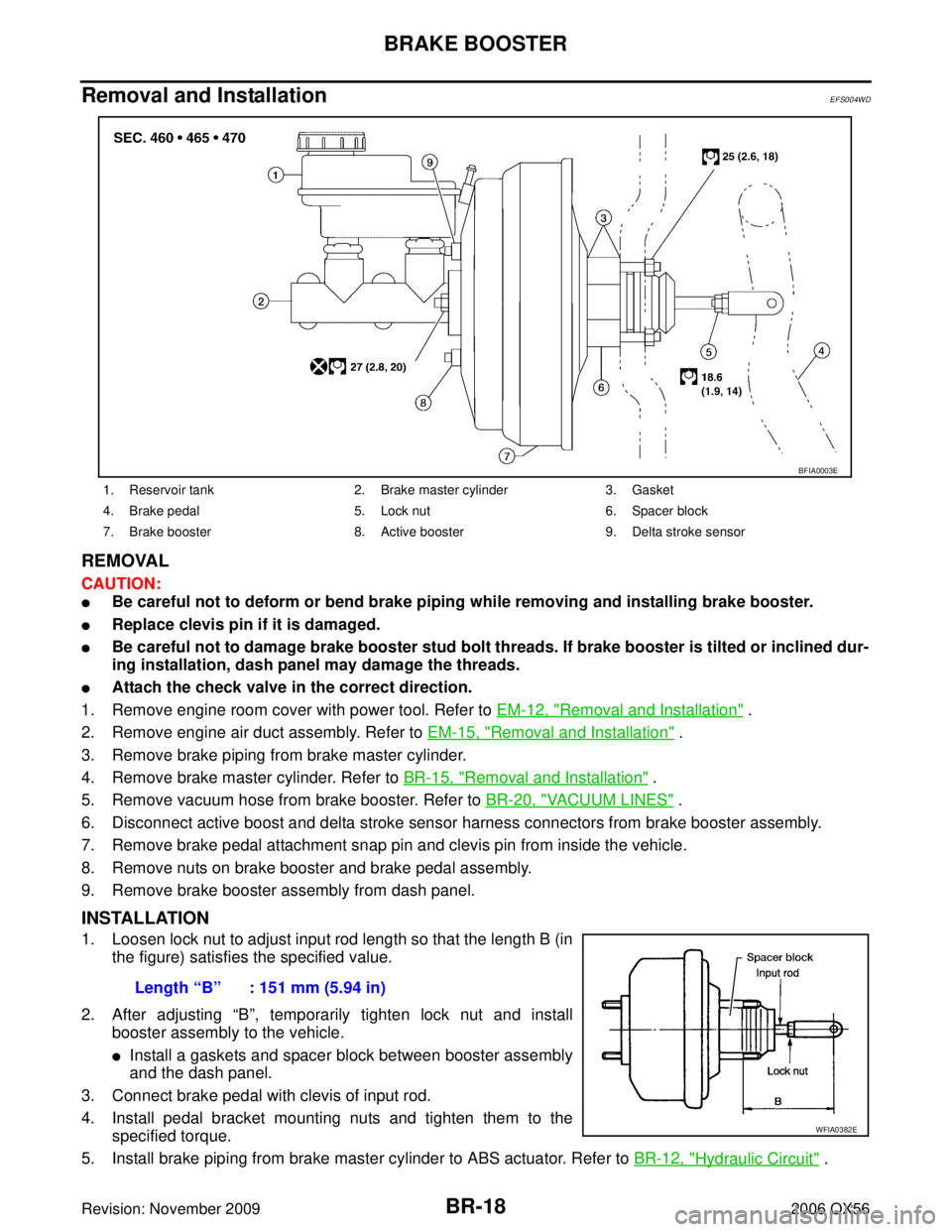
BR-18
BRAKE BOOSTER
Revision: November 20092006 QX56
Removal and InstallationEFS004WD
REMOVAL
CAUTION:
�Be careful not to deform or bend brake piping while removing and installing brake booster.
�Replace clevis pin if it is damaged.
�Be careful not to damage brake booster stud bolt threads. If brake booster is tilted or inclined dur-
ing installation, dash panel may damage the threads.
�Attach the check valve in the correct direction.
1. Remove engine room cover with power tool. Refer to EM-12, "
Removal and Installation" .
2. Remove engine air duct assembly. Refer to EM-15, "
Removal and Installation" .
3. Remove brake piping from brake master cylinder.
4. Remove brake master cylinder. Refer to BR-15, "
Removal and Installation" .
5. Remove vacuum hose from brake booster. Refer to BR-20, "
VACUUM LINES" .
6. Disconnect active boost and delta stroke sensor harness connectors from brake booster assembly.
7. Remove brake pedal attachment snap pin and clevis pin from inside the vehicle.
8. Remove nuts on brake booster and brake pedal assembly.
9. Remove brake booster assembly from dash panel.
INSTALLATION
1. Loosen lock nut to adjust input rod length so that the length B (in the figure) satisfies the specified value.
2. After adjusting “B”, temporarily tighten lock nut and install
booster assembly to the vehicle.
�Install a gaskets and spacer block between booster assembly
and the dash panel.
3. Connect brake pedal with clevis of input rod.
4. Install pedal bracket mounting nuts and tighten them to the specified torque.
5. Install brake piping from brake master cylinder to ABS actuator. Refer to BR-12, "
Hydraulic Circuit" .
1. Reservoir tank 2. Brake master cylinder 3. Gasket
4. Brake pedal 5. Lock nut 6. Spacer block
7. Brake booster 8. Active booster 9. Delta stroke sensor
BFIA0003E
Length “B” : 151 mm (5.94 in)
WFIA0382E
Page 1017 of 3383
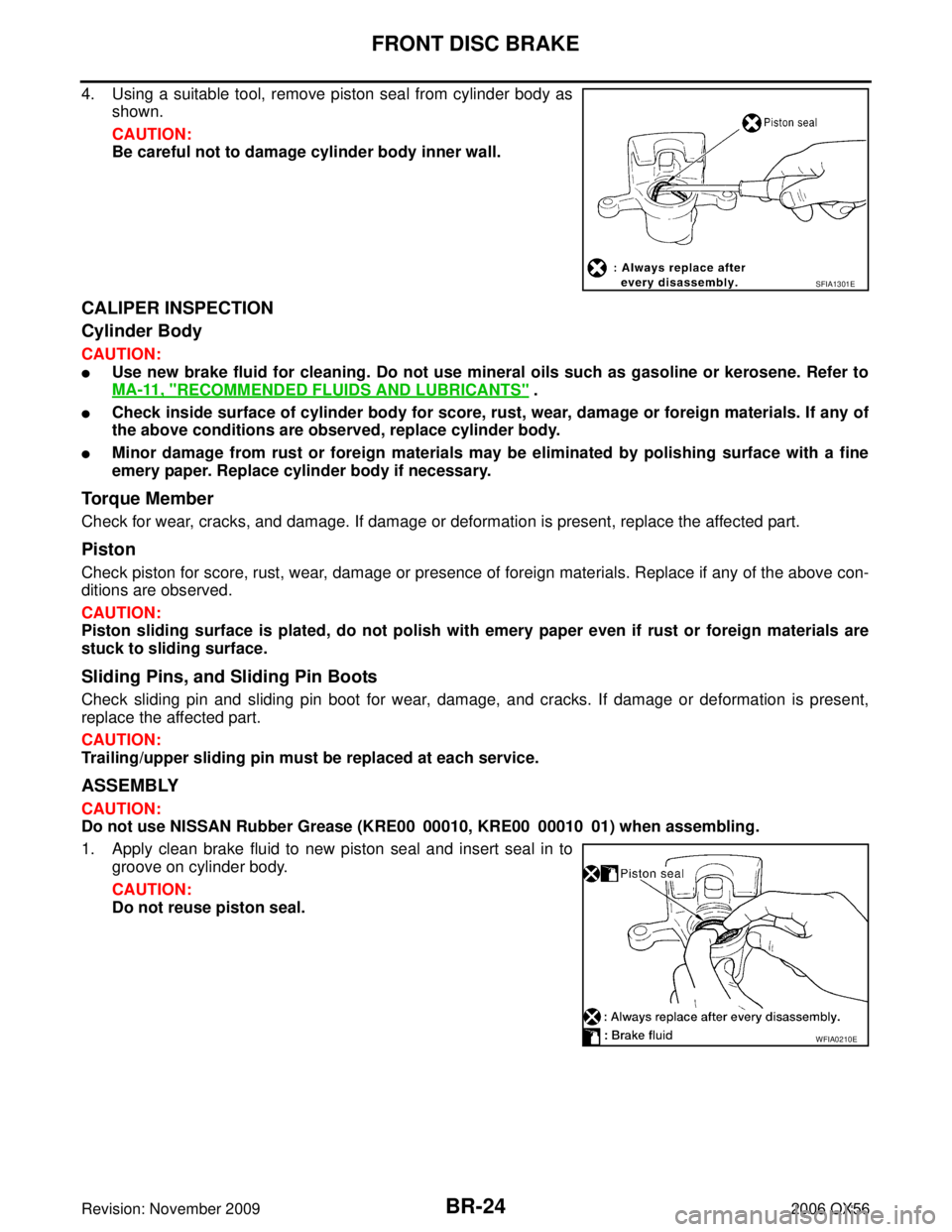
BR-24
FRONT DISC BRAKE
Revision: November 20092006 QX56
4. Using a suitable tool, remove piston seal from cylinder body as
shown.
CAUTION:
Be careful not to damage cylinder body inner wall.
CALIPER INSPECTION
Cylinder Body
CAUTION:
�Use new brake fluid for cleaning. Do not use mineral oils such as gasoline or kerosene. Refer to
MA-11, "
RECOMMENDED FLUIDS AND LUBRICANTS" .
�Check inside surface of cylinder body for score, rust, wear, damage or foreign materials. If any of
the above conditions are observed, replace cylinder body.
�Minor damage from rust or foreign materials may be eliminated by polishing surface with a fine
emery paper. Replace cylinder body if necessary.
To r q u e M e m b e r
Check for wear, cracks, and damage. If damage or deformation is present, replace the affected part.
Piston
Check piston for score, rust, wear, damage or presence of foreign materials. Replace if any of the above con-
ditions are observed.
CAUTION:
Piston sliding surface is plated, do not polish with emery paper even if rust or foreign materials are
stuck to sliding surface.
Sliding Pins, and Sliding Pin Boots
Check sliding pin and sliding pin boot for wear, damage, and cracks. If damage or deformation is present,
replace the affected part.
CAUTION:
Trailing/upper sliding pin must be replaced at each service.
ASSEMBLY
CAUTION:
Do not use NISSAN Rubber Grease (KRE00 00010, KRE00 00010 01) when assembling.
1. Apply clean brake fluid to new piston seal and insert seal in to
groove on cylinder body.
CAUTION:
Do not reuse piston seal.
SFIA1301E
WFIA0210E